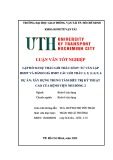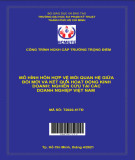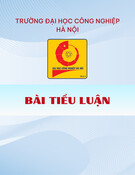
BÁO CÁO TỐT NGHIỆP
Đề tài
Phân tích một số yếu tố ảnh hưởng đến cường độ nén nở hông
của cọc xi măng đất tại công trình đường liên cảng Cái Mép –
Thị Vải và đánh giá hiệu quả của phụ gia muội silic.

ĐẠI HỌC QUỐC GIA TP.HCM
TRƯỜNG ĐẠI HỌC BÁCH KHOA
CỘNG HOÀ XÃ HỘI CHỦ NGHĨA VIỆT NAM
Độc lập – Tự do – Hạnh phúc
TP. Hồ Chí Minh, ngày ….. tháng ….. năm ……
NHIỆM VỤ LUẬN VĂN TỐT NGHIỆP
Khoa: Kỹ thuật Địa Chất và Dầu Khí
Bộ môn: Địa Kỹ Thuật
Họ và tên: NGUYỄN VĂN CƯỜNG MSSV: 30600264
Chuyên nghành: ĐỊA KỸ THUẬT Lớp: DC06KT
1. Đề tài luận văn:
FACTORS AFFECT ON UNCONFINED COMPRESSIVE STRENGTH OF
SOIL CEMENT COLUMN IN THI VAI – CAI MEP INTER-PORT ROAD AND
ASSESSING EFFECT OF SILICA FUME ADMIXTURE
2. Nhiệm vụ luận văn:
- Tiến hành trộn, bảo dưỡng, nén mẫu xi măng đất trong phòng thí nghiệm.
- Tổng hợp, thống kê, phân tích kết quả thí nghiệm, thiết lập biểu đồ thể hiện các
mối tương quan, đánh giá kết quả thí nghiệm.
- Tiến hành so sánh sự khác biệt giữa cường độ cọc đất xi măng thực tế so với
mẫu trộn trong phòng thí nghiệm.
- Trình bày, luận giải các yếu tố ảnh hưởng đến cường độ cọc xi măng đất.
3. Ngày giao nhiệm vụ luận văn: 01/08/2010
4. Ngày hoàn thành luận văn: 30/12/2010

5. Cán bộ hướng dẫn: ThS. Nguyễn Thanh Nhàn, TS Nguyễn Minh Trung.
CÁN BỘ HƯỚNG DẪN 1
(Ký và ghi rõ họ tên)
CÁN BỘ HƯỚNG DẪN 2
(Ký và ghi rõ họ tên)
Nội dung và yêu cầu của luận văn đã được thông qua bộ môn
Ngày ….. tháng ….. năm 20…
CHỦ NHIỆM BỘ MÔN
(Ký và ghi rõ họ tên)

i
ACKNOWLEDGEMENT
And there come a day when I do graduated thesis, still there be joyful to get
graduation. The helps and continuous supports from teachers, friends, and family
whom I am most grateful make me mature. Without you, all of you, I don’t know who
I am today. I would like to thank each of you individually by word, but also I do in my
heart.
I would like to express my deepest gratitude to my supervisor, MSc. Nguyen
Thanh Nhan and Dr. Nguyen Minh Trung, with a spirit of enterprise for his strong
support and whole-hearted guidance, encouragement and advice in this study.
Especially, MSc Nguyen Thanh Nhan, I don’t forget the time when he spent with me
in numerous discussions in this research. His rich knowledge in the geotechnical
engineering has also been most helpful in guiding this study. I have learned a lot from
his thorough and insightful review of this research and his dedication to producing
high quality. In additional, he made me many opportunities to practice. Then I could
directly practice almost theory which I had studied. He made considerable contribution
to my project.
During the time I study, I received helping from all teachers in my department,
especially Dr. Phan Thi San Ha. She helped me to understand clay minerals,
pozzolanic reaction and many problems in geotechnics. My friends, my brothers
helped me to do my graduation thesis enthusiastically. I am grateful to all of you.
Doing this project helped me improve my knowledge of major English very
much. With me, English is very important when I work in the future. Although I tried
my best to finish my graduation thesis in English language, I think it still had many
mistakes. I wish I will receive many contributions of you.
Best regards.
Nguyen Van Cuong

ii
TÓM TẮT
Đề tài LVTN: “Phân tích một số yếu tố ảnh hưởng đến cường độ nén nở hông của cọc
xi măng đất tại công trình đường liên cảng Cái Mép – Thị Vải và đánh giá hiệu quả
của phụ gia muội silic.”
Tuyến đường liên cảng Cái Mép – Thị Vải nối liền hệ thống cảng và các khu
công nghiệp chạy dọc sông Cái Mép - Thị Vải với tổng vốn đầu tư 6300 tỉ đồng. Hiện
đang thi công đoạn số 3 (từ km 7 + 199 – km 9 + 612). Vị trí công trình nằm trên khu
vực đất yếu thuộc trầm trích sông biển hỗn hợp có tính chất phức tạp. Do đó để đảm
bảo khả năng khai thác của tuyến đường tải trọng cao đòi hỏi phải có một giải pháp
nền móng hợp lý và kinh tế. Với những ưu điểm trong công tác xử lý nền đất yếu,
công nghệ cột xi măng đất được xem như giải pháp tối ưu cần phải được xem xét và
ứng dụng rộng rãi.
Để góp phần thực hiện điều này, trong luận văn này tác giả đã tập trung vào
nghiên cứu các vấn đề sau:
- Tìm hiểu cơ sở lý thuyết của phương pháp cọc xi măng đất.
- Tiến hành trộn mẫu trong phòng để phân tích một số yếu tố ảnh hưởng
đến cường độ nén nở hông, đánh giá hiệu quả của phụ gia muội silic và
đưa ra hàm lượng tối ưu.
- Nghiên cứu ảnh hưởng của môi trường xung quanh:
• Chịu ảnh hưởng của nước (điều kiện nước ngầm)
• Sự thay đổi hàm lượng muối trong đất.
• Môi trường đất tự nhiên xung quanh cọc
- So sánh sự khác biệt giữa cường độ cọc đất xi măng thực tế so với mẫu
trộn trong phòng thí nghiệm.


























